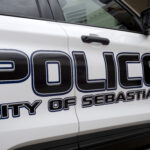SEBASTIAN – The Sebastian Police Department has plans to replace seven of its pursuit vehicles at a cost of nearly $233,000.
The Sebastian City Council unanimously supported the expenditure, though one council member asked that they consider the possibility of equipping future police cars with alternative fuels. Councilman Richard Gillmor made the request the council discuss the option at a later date – before the next round of police cruisers need to be replaced.
“I don’t want to hold up this batch,” Gillmor said, adding that he had spoken with someone during a League of Cities meeting who converts gas-fueled vehicles to ones that run on compressed natural gas.
“You don’t really lose anything,” Gillmor said of the vehicles’ performance.
The Sebastian Police Department has not been keen on replacing pursuit vehicles with electric cars due to performance needs. City Manager Al Minner said that the department prefers to have standard engines in its cruisers.
One concern that law enforcement agencies have had with alternatively fueled pursuit vehicles, according to Gillmor, has been the possibility of running out of fuel and not being able to fill up.
With a small city such as Sebastian, Gillmor said it would be unlikely for an officer to run out of the compressed natural gas.
He added that such a conversion could cost more initially for the department. However, the cost of compressed natural gas is currently a fraction of the price of gasoline – which is predicted to continue to increase.
“That’s a huge savings for the city,” Gillmor said.
The seven cruisers in line to be replaced will be assigned to the Sebastian Police Department’s volunteer patrol, replacing seven of the volunteer high-mileage vehicles, which will be placed in a public auction.
Police Chief Michelle Morris told the council that the department tries to salvage what police equipment it can from the decommissioned vehicles to help offset the cost of buying new.
Nearly one-third of the cost for the new vehicles is tied to the police equipment. The chief explained that the vehicles’ radios and cameras have a lifespan of about five years, so those typically have to be replaced at the time the vehicles are replaced.
Lights and other equipment, however, can be repurposed for the volunteer force.






